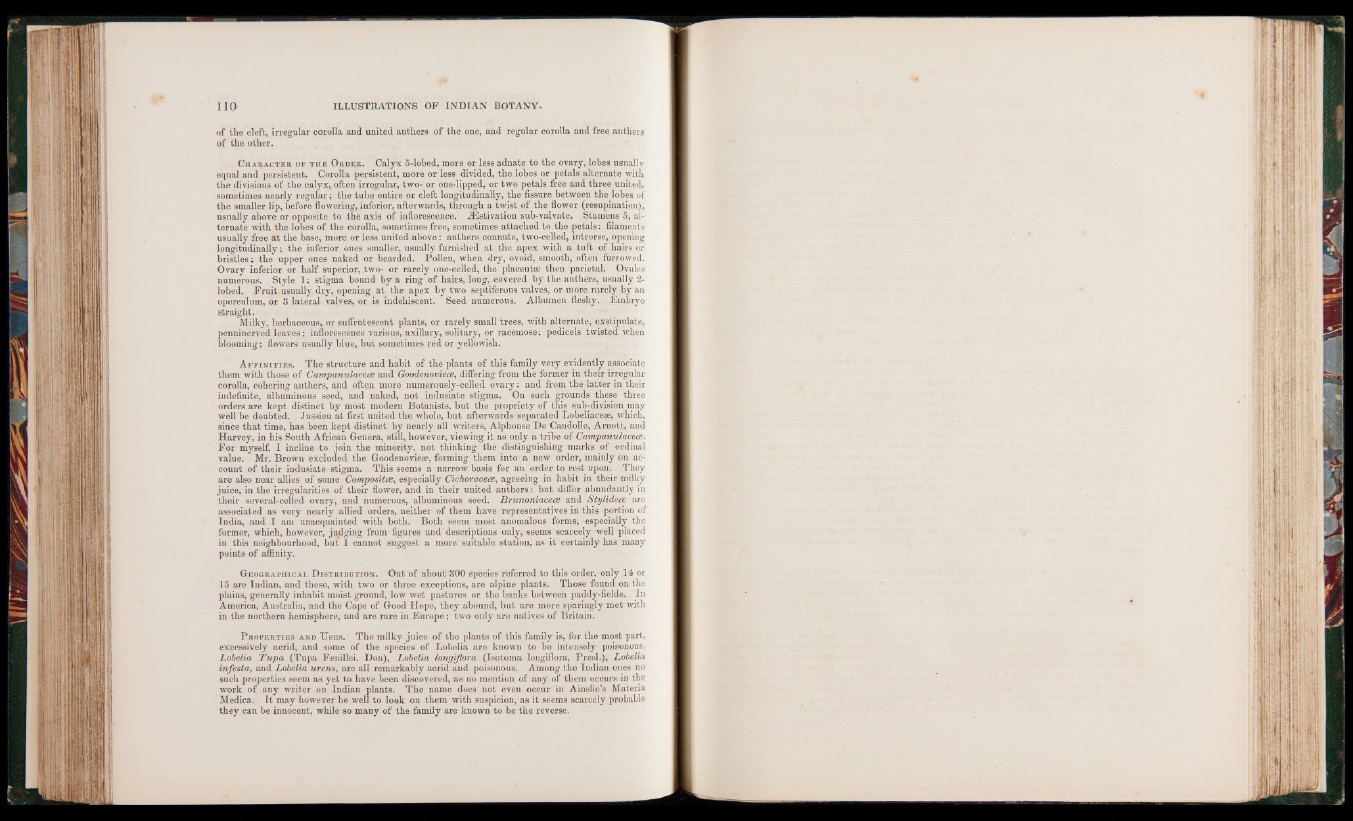
of the cleft, irregular corolla and united anthers of the one, and regular corolla and free anthers
of the other.
Character of the Order. Calyx 5-lobed, more or less adnate to the ovary, lobes usually
equal and persistent. Corolla persistent, more or less divided, the lobes or petals alternate with
the divisions of the calyx, often irregular, two- or one-lipped, or two petals free and three united,
sometimes nearly regular; the tube entire or cleft longitudinally, the fissure between the lobes of
the smaller lip, before flowering, inferior, afterwards, through a twist of the flower (resupination),
usually above or opposite to the axis of inflorescence. ^Estivation sub-valvate. Stamens 5, alternate
with the lobes of the corolla, sometimes free, sometimes attached to the petals: filaments
usually free at the base, more or less united above: anthers connate, two-celled, introrse, opening
longitudinally; the inferior ones smaller, usually furnished at the apex with a tuft of hairs or
bristles; the upper ones naked or bearded. Pollen, when dry, ovoid, smooth, often furrowed.
Ovary inferior or half superior, two- or rarely one-celled, the placentae then parietal. Ovules
numerous. Style 1; stigma bound by a ring of hairs, long, covered by the anthers, usually 2-
lobed. Fruit usually dry, opening at the apex by two septiferous valves, or more rarely by an
operculum, or 3 lateral valves, or is indehiscent. Seed numerous. Albumen fleshy. Embryo
straight.
Milky, herbaceous, or suffrutescent plants, or rarely small trees, with alternate, exstipulate,
penninerved leaves; inflorescence various, axillary, solitary, or racemose; pedicels twisted when
blooming; flowers usually blue, but sometimes red or yellowish.
Af f in it ies . The structure and habit of the plants of this family very evidently associate
them with those of Campanulaceoe and Goodenoviece, differing from the former in their irregular
corolla, cohering anthers, and often more numerously-celled ovary: and from the latter in their
indefinite, albuminous seed, and naked, not indusiate stigma. On such grounds these three
orders are kept distinct by most modern Botanists, but the propriety of this sub-division may
well be doubted. Jussieu at first united the whole, but afterwards separated Lobeliacese, which,
since that time, has been kept distinct by nearly all writers, Alphonse De Candolle, Arnott, and
Harvey, in his South African Genera, still, however, viewing it as only a tribe of Campanulacece.
For myself, I incline to join the minority, not thinking the distinguishing marks of ordinal
value. Mr. Brown excluded the Goodenovieae, forming them into a new order, mainly on account
of their indusiate stigma. This seems a narrow basis for an order to rest upon. They
are also near allies of some Com/positce, especially Cichoracece, agreeing in habit in their milky
juice, in the irregularities of their flower, and in their united anthers: but differ abundantly in
their several-celled ovary, and numerous, albuminous seed. Brunoniacece and StylidecB are
associated as very nearly allied orders, neither of them have representatives in this portion of
India, and I am unacquainted with both. Both seem most anomalous forms, especially the
former, which, however, judging from figures and descriptions only, seems scarcely well placed
in this neighbourhood, but I cannot suggest a more suitable station, as it certainly has many
points of affinity.
Geographical D istribution. Out of about 300 species referred to this order, only 14 or
15 are Indian, and these, with two or three exceptions, are alpine plants. Those found on the
plains, generally inhabit moist ground, low wet pastures or the banks between paddy-fields. In
America, Australia, and the Cape of Good Hope, they abound, but are more sparingly met with
in the northern hemisphere, and are rare in Europe; two only are natives of Britain.
P roperties and U ses. The milky juice of the plants of this family is, for the most part,
excessively acrid, and some of the species of Lobelia are known to be intensely poisonous.
Lobelia Tivpa (Tupa Fenillei. Don), Lobelia longiflora (Isotoma longiflora, Presl.), Lobelia
infesta, and Lobelia wrens, are all remarkably acrid and poisonous. Among the Indian ones no
such properties seem as yet to have been discovered, as no mention of any of them occurs in the
work of any writer on Indian plants. The name does not even occur in Ainslie’s Materia
Medica. I t may however be well to look on them with suspicion, as it seems scarcely probable
they can be innocent, while so many of the family are known to be the reverse.